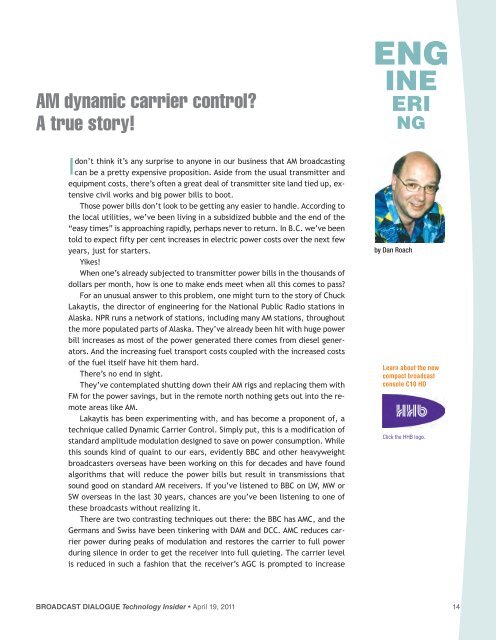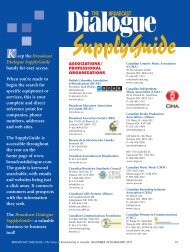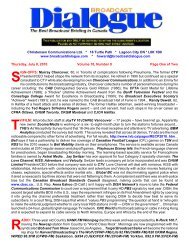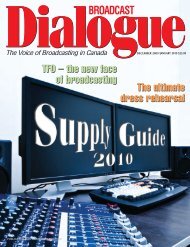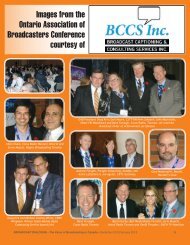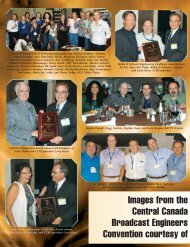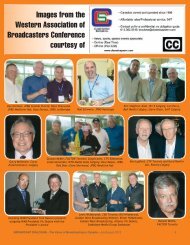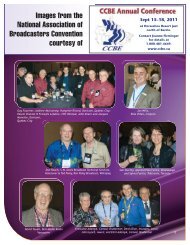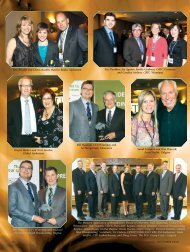Current PDF Edition - Broadcast Dialogue
Current PDF Edition - Broadcast Dialogue
Current PDF Edition - Broadcast Dialogue
Create successful ePaper yourself
Turn your PDF publications into a flip-book with our unique Google optimized e-Paper software.
AM dynamic carrier control?<br />
A true story!<br />
Idon’t think it’s any surprise to anyone in our business that AM broadcasting<br />
can be a pretty expensive proposition. Aside from the usual transmitter and<br />
equipment costs, there’s often a great deal of transmitter site land tied up, extensive<br />
civil works and big power bills to boot.<br />
Those power bills don’t look to be getting any easier to handle. According to<br />
the local utilities, we’ve been living in a subsidized bubble and the end of the<br />
“easy times” is approaching rapidly, perhaps never to return. In B.C. we’ve been<br />
told to expect fifty per cent increases in electric power costs over the next few<br />
years, just for starters.<br />
Yikes!<br />
When one’s already subjected to transmitter power bills in the thousands of<br />
dollars per month, how is one to make ends meet when all this comes to pass?<br />
For an unusual answer to this problem, one might turn to the story of Chuck<br />
Lakaytis, the director of engineering for the National Public Radio stations in<br />
Alaska. NPR runs a network of stations, including many AM stations, throughout<br />
the more populated parts of Alaska. They’ve already been hit with huge power<br />
bill increases as most of the power generated there comes from diesel generators.<br />
And the increasing fuel transport costs coupled with the increased costs<br />
of the fuel itself have hit them hard.<br />
There’s no end in sight.<br />
They’ve contemplated shutting down their AM rigs and replacing them with<br />
FM for the power savings, but in the remote north nothing gets out into the remote<br />
areas like AM.<br />
Lakaytis has been experimenting with, and has become a proponent of, a<br />
technique called Dynamic Carrier Control. Simply put, this is a modification of<br />
standard amplitude modulation designed to save on power consumption. While<br />
this sounds kind of quaint to our ears, evidently BBC and other heavyweight<br />
broadcasters overseas have been working on this for decades and have found<br />
algorithms that will reduce the power bills but result in transmissions that<br />
sound good on standard AM receivers. If you’ve listened to BBC on LW, MW or<br />
SW overseas in the last 30 years, chances are you’ve been listening to one of<br />
these broadcasts without realizing it.<br />
There are two contrasting techniques out there: the BBC has AMC, and the<br />
Germans and Swiss have been tinkering with DAM and DCC. AMC reduces carrier<br />
power during peaks of modulation and restores the carrier to full power<br />
during silence in order to get the receiver into full quieting. The carrier level<br />
is reduced in such a fashion that the receiver’s AGC is prompted to increase<br />
ENG<br />
INE<br />
ERI<br />
NG<br />
by Dan Roach<br />
Learn about the new<br />
compact broadcast<br />
console C10 HD<br />
Click the HHB logo.<br />
BROADCAST DIALOGUE Technology Insider • April 19, 2011 14


